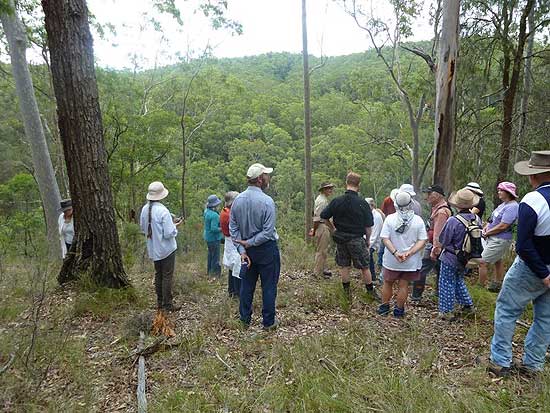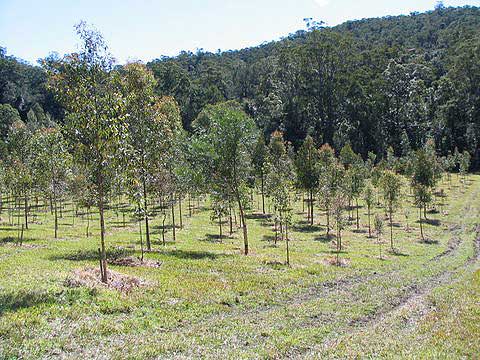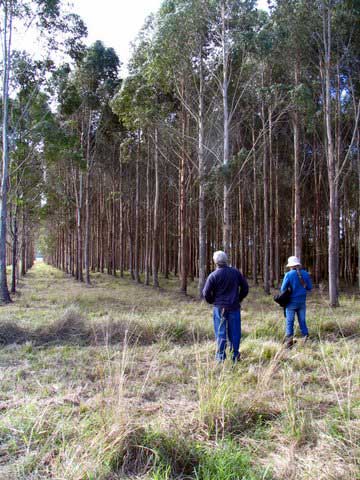March 2011 Field day
A 100 hectare property at Mount Vincent was inspected by over twenty people. Sixty percent of the property is a voluntary conservation area including endangered ecological communities, a gorge and rainforest and a range of other conservation values. The remainder of the property is being managed as private native forestry with a property vegetation plan being prepared. Significant management issues are coordinating the two major landuses and the success achieved in reducing lantana by the splattter gun approach.
October 2010 Field day
A hardy band of HFFN members travelled to the scenic Upper Hunter to inspect two properties over two days. A common theme was the effect of extreme events on trees.
On the first property, located in high, steep country in the Upper Rouchel Brook valley dominated by stringybarks, fire moved through the area over a two week period in November 2009. The trunks of most trees were blackened and epicormic growth was much in evidence. While some trees were destroyed, the majority appeared that they would survive with only a small amount of long term damage. An obvious management strategy is to keep debris away from the base of trees to reduce the possibility of fire reaching the crowns. Back burns to protect assets can be more effective if done just prior to the threat. If done too early, litter has a chance to re accumulate.
At the second property, located in the Martindale Creek valley, plantations of over 3000 trees, including spotted gum, ironbark, grey gum, slatey gum, white box and casuarina have been established. Typical tree spacing is 4m x 3m. In addition to frost and wallaby grazing, drought had a profound effect on the success rate of the plantings. There is an extensive area of ecologically valuable slatey gum on the higher country. Management lessons include: planting must be timed to the local seasonal conditions; ripping along the contour to retain runoff was effective on the higher and dryer areas, however the rip line soon disappeared on the alluvial flats; keep plantings away from established trees that are sucking up the moisture; initial planting of wattle and casuarina can assist the growth of eucalypts interplanted a bit later. The landowner’s overall conclusion is that plantations are useful as windbreaks, but management of regrowth is a better option for timber production.
August 2010 Field day
Beautiful weather and the picturesque setting of the Upper Karuah Valley made for an enjoyable day for the nearly 40 people who attended the August field day on two adjacent properties.
On the first property, a three year old plantation of some 1500 trees of mixed species, most endemic to the local area, was inspected. Tree spacing was generally 4 metres and some trees had reached 6 metres in height. Factors affecting growth included moisture distribution and shading from adjacent forest. A Mahoe twin blade transportable mill is used for milling single selection trees from the property’s native forest for rural fencing products and small quantities of flooring, decking and palings.
A forest management plan of the second property was presented. This details the composition and condition of the forest, recommended silviculture regimes and possible products. Part of the property containing single age forest, resulting from previous clearing, was inspected and appropriate management to encourage species diversity was discussed.
June 2010 Field day
Over twenty people visited two properties in the lower Manning valley where the one owner has been developing extensive native planations for over thirty years. On the higher property the main species have been blackbutt and flooded gum, with most trees at an advanced stage. On the more low lying property, as well as flooded gum, swamp mahogany, tallowwood and blackwood have been planted. Frost damage has occcurred to the latter two species, although the tallowwood especially are recovering. The flooded gum have performed differently on different sites, with varying drainage conditions a likely important factor. Preparations for planting involved ripping and forming linear mounds in which to plant tube stock. A planting rate of up to 1000 trees per day has been achieved by the farmer working alone. Maintenance activities have included pruning, slashing between the rows, brushcutting between trees in a row and controlled grazing.
March 2010 Field day
A property on the alluvial flats of the Crawford River was visited. It had previously been a dairy farm and a vegetable market garden. A Paulownia plantation had been established prior to the current owner taking over about four years ago, with the plantation size increased since then. We inspected trees at different stages of their life cycle and different planting and management methods. There was an interesting discussion of drying and marketing the timber. The property also had an area close to the river of recent plantings of native trees. After a hike over elevated parts of the property to view areas proposed for bush food crops we dashed through the driving rain to shelter, lunch and the formal meeting, including discussion on the recent Private Native Forestry initiatives.
November 2009 Field day
The venue for the November field day was changed at the last minute, because the miller no longer had a mill. The day was held at a biodynamic farm which has just established a small plantation. We inspected the plantation and many other plantings on the farm, including some very impressive river bank replanting. We were driven inside by some rain and forced to have an AGM and plan for 2010. a pleasant way to cap off another year.
September 2009 Field day
On Saturday a small but enthusiastic crew visited a site at Howes Valley with a known fire history for the last 30 years. We cut cross sections through a fallen tree and carefully cut epicormic shoots away from the bark to examine the effect of fire on the timber.
On Sunday a large crowd listened to an expose on fire shelters, fine furniture and paulownia trees at Wollombi. Afterwards we were taken for a walk into a nearby forest where there is a HUGE iron bark – much bigger than any other known ironbark tree. A fascinating day with some excellent repartee.
July 2009 Field day
An interesting day reviewing a previous field day site at Maitland Vale. The site was part of a thinning and plantation trial. Thinning trial was remeasured with a pleasing result showing the basil area had returned to the pre-thinning value after approximately 6 years. Meanwhile, down in the plantation, there was a pruning tool shoot out with the chain saw pole pruner facing up to the pole saw and electric pole pruners. Predictably, each had strengths and weaknesses. The day ended with a tree planting session on the creek where the June 2007 flood had removed previous plantings. A well attended and enjoyable day.
June 2009 Field day
A well attended meeting with the usual flair for turning out a fine feed for morning tea and lunch. A particular prize to our host member for the innovative water boiler. Our host walked us through the trials and tribulations of preparing property vegetation plans and obtaining permission to log a private native forest. This was followed by an inspection of the proposed logging area and lively discussion on the operations plan and the code. An interesting and stimulating meeting.
April 2009 Field day
Unfortunately postponed till 14 June.


